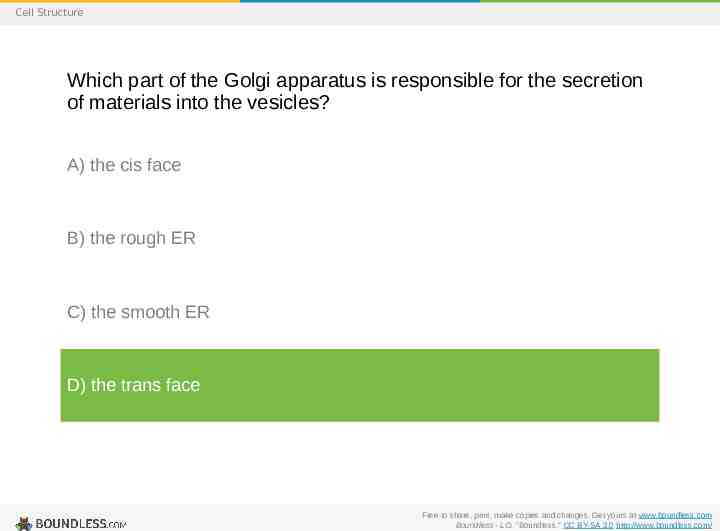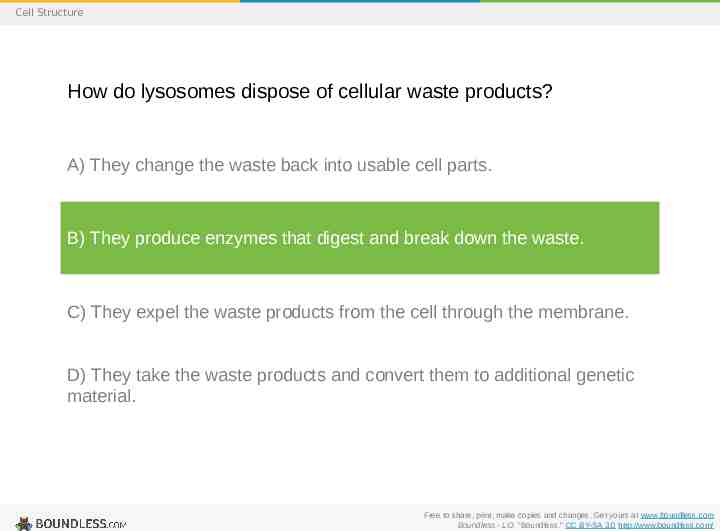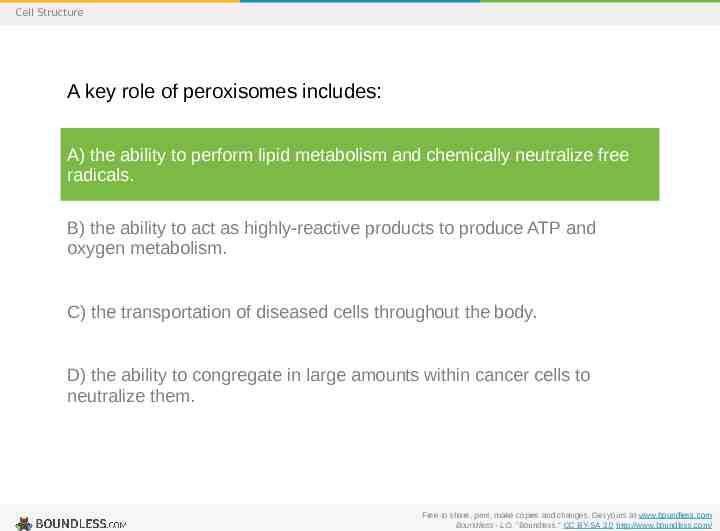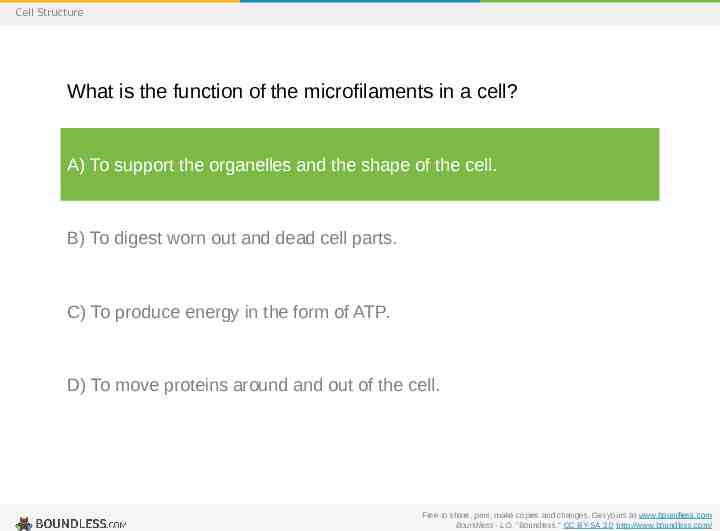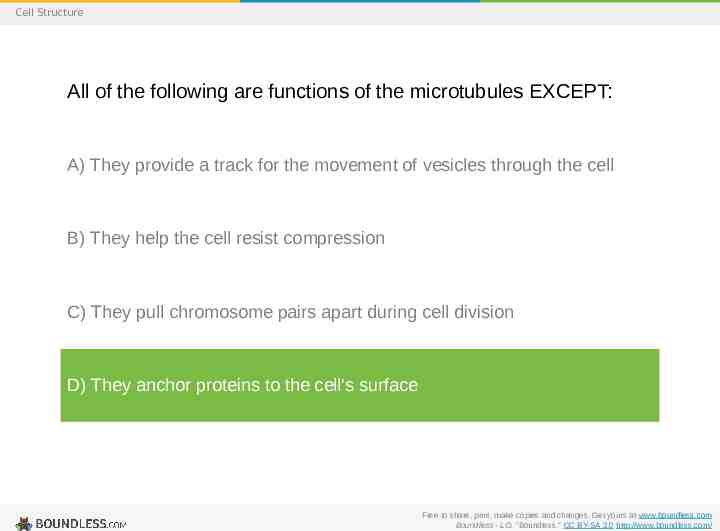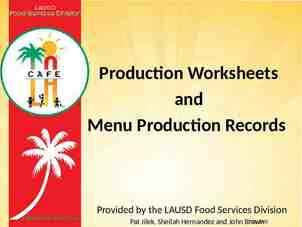Cell Structure Studying Cells Prokaryotic Cells Eukaryotic Cells The
97 Slides5.60 MB
Cell Structure Studying Cells Prokaryotic Cells Eukaryotic Cells The Endomembrane System and Proteins The Cytoskeleton The Connections between Cells and Cellular Activities Boundless.com/biology?campaign content book 1514 c hapter 4&campaign term Biology&utm campaign power point&utm medium direct&utm source boundless Free to share, print, make copies and changes. Get yours at www.boundless.com
Cell Structure Studying Cells Studying Cells Cells as the Basic Unit of Life Microscopy Cell Theory Free to share, print, make copies and changes. Get yours at www.boundless.com www.boundless.com/biology?campaign content book 1514 chapter 4&campaign term Biology&utm campaign powerpoint&utm medium dire ct&utm source boundless
Cell Structure Studying Cells Cells as the Basic Unit of Life A living thing can be composed of either one cell or many cells. There are two broad categories of cells: prokaryotic and eukaryotic cells. Cells can be highly specialized with specific functions and characteristics. Various Cell Types View on Boundless.com Free to share, print, make copies and changes. Get yours at www.boundless.com www.boundless.com/biology/textbooks/boundless-biology-textbook/cell-structure-4/studying-cells-58/cells-as-the-basic-unit-of-life-309-11442?cam paign content book 1514 chapter 4&campaign term Biology&utm campaign powerpoint&utm medium direct&utm source boundless
Cell Structure Studying Cells Microscopy Electron microscopes use a beam of Light microscopes allow for magnification of an object electrons, opposed to visible light, for approximately up to 400-1000 times magnification. depending on whether the high power or oil immersion objective is Electron microscopes allow for higher magnification in comparison to a light used. Light microscopes use visible light microscope thus, allowing for visualization of which passes and bends through cell internal structures. the lens system. Free to share, print, make copies and changes. Get yours at www.boundless.com www.boundless.com/biology/textbooks/boundless-biology-textbook/cell-structure-4/studying-cells-58/microscopy-310-11443?campaign content b ook 1514 chapter 4&campaign term Biology&utm campaign powerpoint&utm medium direct&utm source boundless
Cell Structure Microbial Size This figure shows relative sizes of microbes on a logarithmic scale (recall that each unit of increase in a logarithmic scale represents a 10-fold increase in the quantity being measured). Free to share, print, make copies and changes. Get yours at www.boundless.com Connexions. "Print." CC BY 3.0 http://cnx.org/content/m44406/latest/Figure 04 02 02.jpg View on Boundless.com
Cell Structure Various Cell Types (a) Nasal sinus cells (viewed with a light microscope), (b) onion cells (viewed with a light microscope), and (c) Vibrio tasmaniensis bacterial cells (seen through a scanning electron microscope) are from very different organisms, yet all share certain characteristics of basic cell structure. Free to share, print, make copies and changes. Get yours at www.boundless.com Connexions. CC BY 3.0 http://cnx.org/content/m44404/latest/Figure 04 00 00.jpg View on Boundless.com
Cell Structure Studying Cells Cell Theory The cell theory describes the basic properties of all cells. The three scientists that contibuted to the development of cell theory are Matthias Schleiden, Theodor Schwann, and Rudolf Virchow. A component of the cell theory is that all living things Structure of an Animal Cell View on Boundless.com are composed of one or more cells. A component of the cell theory is that the cell is the basic unit of life. A component of the cell theory is that all new cells arise from existing cells. Free to share, print, make copies and changes. Get yours at www.boundless.com www.boundless.com/biology/textbooks/boundless-biology-textbook/cell-structure-4/studying-cells-58/cell-theory-311-11444?campaign content bo ok 1514 chapter 4&campaign term Biology&utm campaign powerpoint&utm medium direct&utm source boundless
Cell Structure Prokaryotic Cells Characteristics of Prokaryotic Cells lack an organized nucleus and other membranebound organelles. DNA is found in a central part of the cell called the nucleoid. The cell wall acts as an extra layer of protection, helps maintain cell shape, and prevents dehydration. General Structure of a Prokaryotic Cell View on Boundless.com cell size ranges from 0.1 to 5.0 μm in diameter. The small size allows quick entry and diffusion of ions and molecules to other parts of the cell while also allowing fast removal of waste products out of the cell. Free to share, print, make copies and changes. Get yours at www.boundless.com www.boundless.com/biology/textbooks/boundless-biology-textbook/cell-structure-4/prokaryotic-cells-59/characteristics-of-prokaryotic-cells-312-114 45?campaign content book 1514 chapter 4&campaign term Biology&utm campaign powerpoint&utm medium direct&utm source boundles
Cell Structure Stained Keratin Intermediate filaments Keratin cytoskeletal intermediate filaments are concentrated around the edge of the cells and merge into the surface membrane. This network of intermediate filaments from cell to cell holds together tissues like skin. Free to share, print, make copies and changes. Get yours at www.boundless.com Wikipedia. "Epithelial-cells." GNU FDL http://en.wikipedia.org/wiki/File:Epithelial-cells.jpg View on Boundless.com
Cell Structure Rough Endoplasmic Reticulum This transmission electron micrograph shows the rough endoplasmic reticulum and other organelles in a pancreatic cell. Free to share, print, make copies and changes. Get yours at www.boundless.com Connexions. "Print." CC BY 3.0 http://cnx.org/content/m44435/latest/Figure 04 04 02 new.jpg View on Boundless.com
Cell Structure Cell Surface Size Notice that as a cell increases in size, its surface area-to-volume ratio decreases.When there is insufficient surface area to support a cell's increasing volume, a cell will either divide or die.The cell on the left has a volume of 1 mm3 and a surface area of 6 mm2, with a surface area-to-volume ratio of 6 to 1, whereas the cell on the right has a volume of 8 mm3 and a surface area of 24 mm2, with a surface area-to-volume ratio of 3 to 1. Free to share, print, make copies and changes. Get yours at www.boundless.com Connexions. CC BY 3.0 http://cnx.org/content/m44406/latest/Figure 04 02 03.png View on Boundless.com
Cell Structure Cellulose Cellulose is a long chain of β-glucose molecules connected by a 1-4 linkage. The dashed lines at each end of the figure indicate a series of many more glucose units. The size of the page makes it impossible to portray an entire cellulose molecule. Free to share, print, make copies and changes. Get yours at www.boundless.com Connexions. "Print." CC BY 3.0 http://cnx.org/content/m44407/latest/Figure 04 03 09.jpg View on Boundless.com
Cell Structure Ribosomes are responsible for protein synthesis Ribosomes are made up of a large subunit (top) and a small subunit (bottom). During protein synthesis, ribosomes assemble amino acids into proteins. Free to share, print, make copies and changes. Get yours at www.boundless.com Connexions. "Eukaryotic Cells." CC BY 3.0 http://cnx.org/content/m44407/latest/?collection col11448/latest View on Boundless.com
Cell Structure General Structure of a Prokaryotic Cell This figure shows the generalized structure of a prokaryotic cell.All prokaryotes have chromosomal DNA localized in a nucleoid, ribosomes, a cell membrane, and a cell wall.The other structures shown are present in some, but not all, bacteria. Free to share, print, make copies and changes. Get yours at www.boundless.com Connexions. "CNX Bio Majors bacterial cell CS3." CC BY 3.0 http://cnx.org/content/m44406/latest/Figure 04 02 01.jpg View on Boundless.com
Cell Structure Eukaryotic Cells Eukaryotic Cells Characteristics of Eukaryotic Cells The Plasma Membrane and the Cytoplasm The Nucleus and Ribosomes Mitochondria Comparing Plant and Animal Cells Free to share, print, make copies and changes. Get yours at www.boundless.com www.boundless.com/biology?campaign content book 1514 chapter 4&campaign term Biology&utm campaign powerpoint&utm medium dire ct&utm source boundless
Cell Structure Eukaryotic Cells Larger than prokaryotic cells and have a "true" nucleus, membrane-bound Characteristics of Eukaryotic Cells organelles, and rod-shaped chromosomes. The nucleus houses the cell's DNA and directs the synthesis of proteins and ribosomes. Mitochondria are responsible for ATP production; The endoplasmic reticulum modifies proteins and synthesizes lipids The golgi apparatus is where the sorting of lipids and proteins takes place. Perixisomes carry out oxidation reactions that break down fatty acids and amino acids and detoxify poisons Vesicles and vacuoles function in storage and transport. Animal cells have a centrosome and lysosomes while plant cells do not. Plant cells have a cell wall, a large central vacuole, chloroplasts, and other specialized plastids, whereas animal cells do not. Free to share, print, make copies and changes. Get yours at www.boundless.com www.boundless.com/biology/textbooks/boundless-biology-textbook/cell-structure-4/eukaryotic-cells-60/characteristics-of-eukaryotic-cells-313-1144 6?campaign content book 1514 chapter 4&campaign term Biology&utm campaign powerpoint&utm medium direct&utm source boundless
Cell Structure Eukaryotic Nucleus The nucleus stores chromatin (DNA plus proteins) in a gel-like substance called the nucleoplasm.The nucleolus is a condensed region of chromatin where ribosome synthesis occurs.The boundary of the nucleus is called the nuclear envelope.It consists of two phospholipid bilayers: an outer membrane and an inner membrane.The nuclear membrane is continuous with the endoplasmic reticulum.Nuclear pores allow substances to enter and exit the nucleus. Free to share, print, make copies and changes. Get yours at www.boundless.com Connexions. CC BY 3.0 http://cnx.org/content/m44407/latest/Figure 04 03 04.jpg View on Boundless.com
Cell Structure Eukaryotic Cells The Plasma Membrane and the Cytoplasm All eukaryotic cells have a surrounding plasma membrane, which is also known as the cell membrane. The plasma membrane is made up by a phospholipid bilayer with embedded proteins that separates the internal contents of the cell from its surrounding environment. Only relatively small, non-polar materials can easily move through the lipid bilayer of the plasma membrane. Passive transport is the movement of substances across the membrane that does not require the use of energy while active transport is the movement of substances across the membrane using energy. Osmosis is the diffusion of water through a semi-permeable membrane down its concentration gradient; this occurs when there is an imbalance of solutes outside of a cell compared to the inside the cell. Free to share, print, make copies and changes. Get yours at www.boundless.com www.boundless.com/biology/textbooks/boundless-biology-textbook/cell-structure-4/eukaryotic-cells-60/the-plasma-membrane-and-the-cytoplasm314-11447?campaign content book 1514 chapter 4&campaign term Biology&utm campaign powerpoint&utm medium direct&utm source b
Cell Structure Eukaryotic Plasma Membrane The eukaryotic plasma membrane is a phospholipid bilayer with proteins and cholesterol embedded in it. Free to share, print, make copies and changes. Get yours at www.boundless.com Connexions. "Print." CC BY 3.0 http://cnx.org/content/m44407/latest/Figure 04 03 02.jpg View on Boundless.com
Cell Structure Phospholipid Bilayer The phospholipid bilayer consists of two adjacent sheets of phospholipids, arranged tail to tail. The hydrophobic tails associate with one another, forming the interior of the membrane. The polar heads contact the fluid inside and outside of the cell. Free to share, print, make copies and changes. Get yours at www.boundless.com Connexions. "The Cell Membrane." CC BY 3.0 http://cnx.org/content/m46021/latest/ View on Boundless.com
Cell Structure Osmosis Osmosis is the diffusion of water through a semipermeable membrane down its concentration gradient. If a membrane is permeable to water, though not to a solute, water will equalize its own concentration by diffusing to the side of lower water concentration (and thus the side of higher solute concentration). In the beaker on the left, the solution on the right side of the membrane is hypertonic. Free to share, print, make copies and changes. Get yours at www.boundless.com Connexions. "The Cell Membrane." CC BY 3.0 http://cnx.org/content/m46021/latest/ View on Boundless.com
Cell Structure Eukaryotic Cells The Nucleus and Ribosomes The nucleus contains the cell's DNA and directs the synthesis of ribosomes and proteins. Found within the nucleoplasm, the nucleolus is a condensed region of chromatin where ribosome synthesis occurs. Chromatin consists of DNA wrapped around histone proteins and is stored within the DNA is highly organized View on Boundless.com nucleoplasm. Ribosomes are large complexes of protein and ribonucleic acid (RNA) responsible for protein synthesis when DNA from the nucleus is transcribed. Free to share, print, make copies and changes. Get yours at www.boundless.com www.boundless.com/biology/textbooks/boundless-biology-textbook/cell-structure-4/eukaryotic-cells-60/the-nucleus-and-ribosomes-315-11449?ca mpaign content book 1514 chapter 4&campaign term Biology&utm campaign powerpoint&utm medium direct&utm source boundless
Cell Structure The nucleus stores the hereditary material of the cell The nucleus is the control center of the cell. The nucleus of living cells contains the genetic material that determines the entire structure and function of that cell. Free to share, print, make copies and changes. Get yours at www.boundless.com Connexions. "The Nucleus and DNA Replication." CC BY 3.0 http://cnx.org/content/m46073/latest/ View on Boundless.com
Cell Structure Eukaryotic Cells Mitochondria Contain their own ribosomes and DNA; combined with their double membrane, these features suggest that they might have once been free-living prokaryotes that were engulfed by a larger cell. Have an important role in cellular respiration through the production of ATP, using chemical energy found in glucose and other nutrients. Mitochondrial structure View on Boundless.com Responsible for generating clusters of iron and sulfur, which are important cofactors of many enzymes. Free to share, print, make copies and changes. Get yours at www.boundless.com www.boundless.com/biology/textbooks/boundless-biology-textbook/cell-structure-4/eukaryotic-cells-60/mitochondria-316-11451?campaign conten t book 1514 chapter 4&campaign term Biology&utm campaign powerpoint&utm medium direct&utm source boundless
Cell Structure Mitochondrial structure This electron micrograph shows a mitochondrion as viewed with a transmission electron microscope. This organelle has an outer membrane and an inner membrane. The inner membrane contains folds, called cristae, which increase its surface area. The space between the two membranes is called the intermembrane space, and the space inside the inner membrane is called the mitochondrial matrix. ATP synthesis takes place on the inner membrane. Free to share, print, make copies and changes. Get yours at www.boundless.com Connexions. "Print." CC BY 3.0 http://cnx.org/content/m44407/latest/Figure 04 03 07.jpg View on Boundless.com
Cell Structure Eukaryotic Cells Comparing Plant and Animal Cells Centrosomes and lysosomes are found in animal cells, but do not exist within plant cells. The lysosomes are the animal cell's "garbage disposal", while in plant cells the same function takes place in vacuoles. Plant cells have a cell wall, chloroplasts and other specialized plastids, and a large central vacuole, which are not found within animal cells. The cell wall is a rigid covering that protects the cell, provides structural support, and gives shape to the cell. The chloroplasts, found in plant cells, contain a green pigment called chlorophyll, which captures the light energy that drives the reactions of plant photosynthesis. The central vacuole plays a key role in regulating a plant cell's concentration of water in changing environmental conditions. Free to share, print, make copies and changes. Get yours at www.boundless.com www.boundless.com/biology/textbooks/boundless-biology-textbook/cell-structure-4/eukaryotic-cells-60/comparing-plant-and-animal-cells-318-1145 4?campaign content book 1514 chapter 4&campaign term Biology&utm campaign powerpoint&utm medium direct&utm source boundless
Cell Structure Plant Cells Plant cells have a cell wall, chloroplasts, plasmodesmata, and plastids used for storage, and a large central vacuole, whereas animal cells do not. Free to share, print, make copies and changes. Get yours at www.boundless.com Connexions. "Eukaryotic Cells." CC BY 3.0 http://cnx.org/content/m45432/latest/ View on Boundless.com
Cell Structure Free to share, print, make copies and changes. Get yours at www.boundless.com Connexions. "Eukaryotic Cells." CC BY 3.0 http://cnx.org/content/m45432/latest/ View on Boundless.com
Cell Structure The Chloroplast Structure The chloroplast has an outer membrane, an inner membrane, and membrane structures called thylakoids that are stacked into grana. The space inside the thylakoid membranes is called the thylakoid space. The light harvesting reactions take place in the thylakoid membranes, and the synthesis of sugar takes place in the fluid inside the inner membrane, which is called the stroma. Free to share, print, make copies and changes. Get yours at www.boundless.com Connexions. "Print." CC BY 3.0 http://cnx.org/content/m44407/latest/Figure 04 03 10.jpg View on Boundless.com
Cell Structure The Endomembrane System and Proteins The Endomembrane System and Proteins The Endoplasmic Reticulum The Golgi Apparatus Lysosomes Peroxisomes Free to share, print, make copies and changes. Get yours at www.boundless.com www.boundless.com/biology?campaign content book 1514 chapter 4&campaign term Biology&utm campaign powerpoint&utm medium dire ct&utm source boundless
Cell Structure The Endomembrane System and Proteins The Endoplasmic Reticulum If the endoplasmic reticulum (ER) has ribosomes attached to it, it is called rough ER; if it does not, then it is called smooth ER. The proteins made by the rough endoplasmic reticulum are for use outside of the cell. Rough Endoplasmic Reticulum View on Boundless.com Functions of the smooth endoplasmic reticulum include synthesis of carbohydrates, lipids, and steroid hormones; detoxification of medications and poisons; and storage of calcium ions. Free to share, print, make copies and changes. Get yours at www.boundless.com www.boundless.com/biology/textbooks/boundless-biology-textbook/cell-structure-4/the-endomembrane-system-and-proteins-61/the-endoplasmic-r eticulum-319-11455?campaign content book 1514 chapter 4&campaign term Biology&utm campaign powerpoint&utm medium direct&utm
Cell Structure The Endomembrane System and Proteins The Golgi Apparatus The Golgi apparatus is a series of flattened sacs that sort and package cellular materials. The Golgi apparatus has a cis face on the ER side and a trans face opposite of the ER. The Golgi apparatus sorts and packages cellular products View on Boundless.com The trans face secretes the materials into vesicles, which then fuse with the cell membrane for release from the cell. Free to share, print, make copies and changes. Get yours at www.boundless.com www.boundless.com/biology/textbooks/boundless-biology-textbook/cell-structure-4/the-endomembrane-system-and-proteins-61/the-golgi-apparatu s-320-11456?campaign content book 1514 chapter 4&campaign term Biology&utm campaign powerpoint&utm medium direct&utm source
Cell Structure The Golgi apparatus sorts and packages cellular products The Golgi apparatus in this white blood cell is visible as a stack of semicircular, flattened rings in the lower portion of the image. Several vesicles can be seen near the Golgi apparatus. Free to share, print, make copies and changes. Get yours at www.boundless.com Connexions. CC BY 3.0 http://cnx.org/content/m44435/latest/Figure 04 04 03.jpg View on Boundless.com
Cell Structure The Endomembrane System and Proteins Lysosomes Breakdown/digest macromolecules, repair cell membranes, and respond against foreign substances such as bacteria, viruses and other antigens. Contain enzymes that break down the macromolecules and foreign invaders. Composed of lipids and proteins, with a single Lysosomes digest foreign substances that might harm the cell membrane covering the internal enzymes to prevent View on Boundless.com the lysosome from digesting the cell itself. Found in all animal cells, but are rarely found within plant cells due to the tough cell wall surrounding a plant cell that keeps out foreign substances. Free to share, print, make copies and changes. Get yours at www.boundless.com www.boundless.com/biology/textbooks/boundless-biology-textbook/cell-structure-4/the-endomembrane-system-and-proteins-61/lysosomes-321-11 457?campaign content book 1514 chapter 4&campaign term Biology&utm campaign powerpoint&utm medium direct&utm source boundle
Cell Structure Lysosomes digest foreign substances that might harm the cell A macrophage has engulfed (phagocytized) a potentially pathogenic bacterium and then fuses with a lysosomes within the cell to destroy the pathogen. Other organelles are present in the cell but for simplicity are not shown. Free to share, print, make copies and changes. Get yours at www.boundless.com Connexions. "Print." CC BY 3.0 http://cnx.org/content/m44435/latest/Figure 04 04 04.jpg View on Boundless.com
Cell Structure The Endomembrane System and Proteins Peroxisomes Lipid metabolism and chemical detoxification are important functions of peroxisomes. Responsible for oxidation reactions that break down fatty acids and amino acids. Oversee reactions that neutralize free radicals, which cause cellular damage and cell death. Chemically neutralize poisons through a process that produces large amounts of toxic H2O2, which is then converted into water and oxygen. The liver is the organ primarily responsible for detoxifying the blood before it travels throughout the body; as a result, liver cells contain large amounts of peroxisomes. Free to share, print, make copies and changes. Get yours at www.boundless.com www.boundless.com/biology/textbooks/boundless-biology-textbook/cell-structure-4/the-endomembrane-system-and-proteins-61/peroxisomes-31711452?campaign content book 1514 chapter 4&campaign term Biology&utm campaign powerpoint&utm medium direct&utm source bound
Cell Structure Peroxisomes Peroxisomes are membrane-bound organelles that contain an abundance of enzymes for detoxifying harmful substances and lipid metabolism. Free to share, print, make copies and changes. Get yours at www.boundless.com Connexions. "The Cytoplasm and Cellular Organelles." CC BY 3.0 http://cnx.org/content/m46023/latest/ View on Boundless.com
Cell Structure The Cytoskeleton The Cytoskeleton Microfilaments Intermediate Filaments and Microtubules Free to share, print, make copies and changes. Get yours at www.boundless.com www.boundless.com/biology?campaign content book 1514 chapter 4&campaign term Biology&utm campaign powerpoint&utm medium dire ct&utm source boundless
Cell Structure The Cytoskeleton Microfilaments Microfilaments assist with cell movement and are made of a protein called actin. Actin works with another protein called myosin to produce muscle movements, Microfilaments are the thinnest component of the cytoskeleton. View on Boundless.com cell division, and cytoplasmic streaming. Microfilaments keep organelles in place within the cell. Free to share, print, make copies and changes. Get yours at www.boundless.com www.boundless.com/biology/textbooks/boundless-biology-textbook/cell-structure-4/the-cytoskeleton-62/microfilaments-322-11458?campaign cont ent book 1514 chapter 4&campaign term Biology&utm campaign powerpoint&utm medium direct&utm source boundless
Cell Structure Microfilaments are the thinnest component of the cytoskeleton. Microfilaments are made of two intertwined strands of actin. Free to share, print, make copies and changes. Get yours at www.boundless.com Connexions. "Print." CC BY 3.0 http://cnx.org/content/m44412/latest/Figure 04 05 02.jpg View on Boundless.com
Cell Structure The Cytoskeleton Intermediate Filaments and Microtubules Microtubules help the cell resist compression, provide a track along which vesicles can move throughout the cell, and are the components of cilia and flagella. Cilia and flagella are hair-like structures that assist with locomotion in some cells, as well as line various structures to trap particles. The structures of cilia and flagella are a "9 2 array," meaning that a ring of nine microtubules is surrounding two more microtubules. Microtubules attach to replicated chromosomes during cell division and pull them apart to opposite ends of the pole, allowing the cell to divide with a complete set of chromosomes in each daughter cell. Free to share, print, make copies and changes. Get yours at www.boundless.com www.boundless.com/biology/textbooks/boundless-biology-textbook/cell-structure-4/the-cytoskeleton-62/intermediate-filaments-and-microtubules-3 23-11460?campaign content book 1514 chapter 4&campaign term Biology&utm campaign powerpoint&utm medium direct&utm source bo
Cell Structure The Centrosome Structure The centrosome consists of two centrioles that lie at right angles to each other. Each centriole is a cylinder made up of nine triplets of microtubules. Nontubulin proteins (indicated by the green lines) hold the microtubule triplets together. Free to share, print, make copies and changes. Get yours at www.boundless.com Connexions. "Print." CC BY 3.0 http://cnx.org/content/m44407/latest/Figure 04 03 08.jpg View on Boundless.com
Cell Structure Micrtubule Structure Microtubules are hollow, with walls consisting of 13 polymerized dimers of α-tubulin and β-tubulin (right image). The left image shows the molecular structure of the tube. Free to share, print, make copies and changes. Get yours at www.boundless.com Connexions. "Print." CC BY 3.0 http://cnx.org/content/m44412/latest/Figure 04 05 04ab.jpg View on Boundless.com
Cell Structure Microtubules are the structural component of flagella This transmission electron micrograph of two flagella shows the 9 2 array of microtubules: nine microtubule doublets surround a single microtubule doublet. Free to share, print, make copies and changes. Get yours at www.boundless.com Connexions. CC BY 3.0 http://cnx.org/content/m44412/latest/Figure 04 05 05.jpg View on Boundless.com
Cell Structure Connections between Cells and Cellular Activities Connections between Cells and Cellular Activities Extracellular Matrix of Animal Cells Intercellular Junctions Free to share, print, make copies and changes. Get yours at www.boundless.com www.boundless.com/biology?campaign content book 1514 chapter 4&campaign term Biology&utm campaign powerpoint&utm medium dire ct&utm source boundless
Cell Structure The Extracellular Matrix of Animal Cells The extracellular matrix consists of a network of proteins and carbohydrates. Free to share, print, make copies and changes. Get yours at www.boundless.com Connexions. "Print." CC BY 3.0 http://cnx.org/content/m44413/latest/Figure 04 06 01.jpg View on Boundless.com
Cell Structure Connections between Cells and Cellular Activities Extracellular Matrix of Animal Cells Cell communication within tissue and tissue formation are main functions of the extracellular matrix of animal cells. Tissue communication is kick-started when a molecule within the matrix binds a receptor; the end results are conformational changes that induce chemical signals that ultimately change activities within the cell. Free to share, print, make copies and changes. Get yours at www.boundless.com www.boundless.com/biology/textbooks/boundless-biology-textbook/cell-structure-4/connections-between-cells-and-cellular-activities-63/extracellul ar-matrix-of-animal-cells-324-11461?campaign content book 1514 chapter 4&campaign term Biology&utm campaign powerpoint&utm mediu
Cell Structure Connections between Cells and Cellular Activities Intercellular Junctions Plasmodesmata Tight junction Desmosomes Gap junctions Plasmodesmata View on Boundless.com Free to share, print, make copies and changes. Get yours at www.boundless.com www.boundless.com/biology/textbooks/boundless-biology-textbook/cell-structure-4/connections-between-cells-and-cellular-activities-63/intercellula r-junctions-325-11462?campaign content book 1514 chapter 4&campaign term Biology&utm campaign powerpoint&utm medium direct&utm
Cell Structure - A plasmodesma is a channel between the cell walls of two adjacent plant cells. Plasmodesmata allow materials to pass from the cytoplasm of one plant cell to the cytoplasm of an adjacent cell. - Similar to plasmodesmata, gap junctions are channels between adjacent cells that allow for the transport of ions, nutrients, and other substances. Free to share, print, make copies and changes. Get yours at www.boundless.com Connexions. "Print." CC BY 3.0 http://cnx.org/content/m44413/latest/Figure 04 06 02.jpg View on Boundless.com
Cell Structure Tight Junctions A watertight seal between two adjacent animal cells, which prevents materials from leaking out of cells. Free to share, print, make copies and changes. Get yours at www.boundless.com Connexions. CC BY 3.0 http://cnx.org/content/m44413/latest/Figure 04 06 03.jpg View on Boundless.com
Cell Structure Desmosomes connect adjacent cells when cadherins in the plasma membrane connect to intermediate filaments. Free to share, print, make copies and changes. Get yours at www.boundless.com Connexions. CC BY 3.0 http://cnx.org/content/m44413/latest/Figure 04 06 04.jpg View on Boundless.com
Cell Structure 1. The smallest unit of biological structure that meets the functional requirements of “living” is the . A) organ B) organelle C) macromolecule D) cell Free to share, print, make copies and changes. Get yours at www.boundless.com
Cell Structure 2. The is the basic unit of life. A) organism B) cell C) tissue D) organ Free to share, print, make copies and changes. Get yours at www.boundless.com
Cell Structure 3. Which of the following best describes traits associated with an electron microscope? A) The microscope stains the electrons in a specimen. B) The microscope uses visible light to identify cell structures. C) The microscope uses a beam of electrons to provide high resolving power and high magnification. D) The microscope allows for a maximum magnification of 1000 times the original size. Free to share, print, make copies and changes. Get yours at www.boundless.com
Cell Structure 4. Which of the following is a core component of the cell theory? A) Both the cell is the basic unit of life and all new cells arise from existing cells. B) All energy flow occurs within the cell. C) The cell is the basic unit of life. D) All new cells arise from existing cells. Free to share, print, make copies and changes. Get yours at www.boundless.com
Cell Structure 5. What makes an organism a prokaryote? A) They have plasma membranes to protect them from their surrounding environment. B) Prokaryotes lack a membrane-bound nucleus and membranous organelles. C) It's cellular components are found within cytoplasm. D) They contain DNA and ribosomes within the cell. Free to share, print, make copies and changes. Get yours at www.boundless.com
Cell Structure 6. Which of the following is NOT a characteristic of prokaryotes? A) DNA B) endoplasmic reticulum C) cell membrane D) cell wall Free to share, print, make copies and changes. Get yours at www.boundless.com
Cell Structure 7. Which of the following is found both in eukaryotic and prokaryotic cells? A) nucleus B) vacuoles C) mitochondrion D) ribosomes Free to share, print, make copies and changes. Get yours at www.boundless.com
Cell Structure 8. Eukaryotic cells contain the following: A) all of these answers B) a nucleus that is not surrounded by a membrane C) structures that specialize in energy production D) circular chromosomal structures within a membrane-bound nucleus Free to share, print, make copies and changes. Get yours at www.boundless.com
Cell Structure 9. Which of the following are correct regarding diffusion through the lipid bilayer that makes up the plasma membrane? A) Large particles cannot fit in between the individual phospholipids that are packed together. B) Only materials that are relatively small and non-polar can go through easily. C) Polar molecules are repelled by the non-polar lipids that line the inside of the bilayer. D) All of these answers are correct. Free to share, print, make copies and changes. Get yours at www.boundless.com
Cell Structure 10. If the nucleolus were not able to carry out its function, which nucleus-synthesized organelles would be affected? A) Proteins B) Chromosomes C) Ribosomes D) DNA Free to share, print, make copies and changes. Get yours at www.boundless.com
Cell Structure 11. A primary function of the nucleus in eukaryotic cells is: A) to produce ATP that powers the cell. B) to contain the cell's hereditary material. C) to synthesize proteins from mRNA. D) to transport proteins outside of the cell. Free to share, print, make copies and changes. Get yours at www.boundless.com
Cell Structure 12. In mitochondria, the process of using oxygen and producing carbon dioxide as a waste product is due to what cellular reaction? A) It is due to mitochondria's generation of iron and sulfur clusters. B) It is a result of important cofactors of many enzymes. C) It is due to the associative reaction of anaerobic eukaryotes and aerobic prokaryotes. D) It is a by-product of cellular respiration. Free to share, print, make copies and changes. Get yours at www.boundless.com
Cell Structure 13. What is an important difference between plant cells and animal cells? A) Heterotrophs capture light energy to produce their own food. B) Animal and bacterial cells contain chlorophyll, but it is not bound within organelles. C) Plants are able to make their own food through the use of chloroplasts, which enable photosynthesis. D) Animal cells are able to capture light energy through stroma. Free to share, print, make copies and changes. Get yours at www.boundless.com
Cell Structure 14. What is the difference in the functioning between rough ER and smooth ER? A) Rough ER makes proteins for use outside of the cell, while smooth ER makes lipids and carbohydrates. B) Rough ER makes proteins for use inside the cell, while smooth ER make proteins for use outside. C) Rough ER is used by animal cells, while smooth ER is only used by plant cells. D) Rough ER detoxifies poisons, while smooth ER creates new cell organelles. Free to share, print, make copies and changes. Get yours at www.boundless.com
Cell Structure 15. Which of these organelles make up the endomembrane system of a cell? A) Ribosomes and nucleoli B) Nucleus and DNA C) Lysosomes and cell membrane D) Rough and smooth endoplasmic reticulum Free to share, print, make copies and changes. Get yours at www.boundless.com
Cell Structure 16. How does the structure of the endoplasmic reticulum help with the transport of proteins? A) The ER is completely covered with ribosomes that move around the cell. B) The ER can attach itself to the cell membrane to move proteins out of the cell. C) The ER is a series of hollow tubes the proteins can move through around the cell. D) The ER tubes connect with the nucleus for direct transport of ribosomes to its membranes. Free to share, print, make copies and changes. Get yours at www.boundless.com
Cell Structure 17. Which part of the Golgi apparatus is responsible for the secretion of materials into the vesicles? A) the cis face B) the rough ER C) the smooth ER D) the trans face Free to share, print, make copies and changes. Get yours at www.boundless.com
Cell Structure 18. How do lysosomes dispose of cellular waste products? A) They change the waste back into usable cell parts. B) They produce enzymes that digest and break down the waste. C) They expel the waste products from the cell through the membrane. D) They take the waste products and convert them to additional genetic material. Free to share, print, make copies and changes. Get yours at www.boundless.com
Cell Structure 19. A key role of peroxisomes includes: A) the ability to perform lipid metabolism and chemically neutralize free radicals. B) the ability to act as highly-reactive products to produce ATP and oxygen metabolism. C) the transportation of diseased cells throughout the body. D) the ability to congregate in large amounts within cancer cells to neutralize them. Free to share, print, make copies and changes. Get yours at www.boundless.com
Cell Structure 20. What is the function of the microfilaments in a cell? A) To support the organelles and the shape of the cell. B) To digest worn out and dead cell parts. C) To produce energy in the form of ATP. D) To move proteins around and out of the cell. Free to share, print, make copies and changes. Get yours at www.boundless.com
Cell Structure 21. All of the following are functions of the microtubules EXCEPT: A) They provide a track for the movement of vesicles through the cell B) They help the cell resist compression C) They pull chromosome pairs apart during cell division D) They anchor proteins to the cell's surface Free to share, print, make copies and changes. Get yours at www.boundless.com
Cell Structure 22. What is the role of the extracellular matrix of animal cells? A) The matrix works in the formation of tissues and allows cell communication within the tissues. B) The matrix is in charge of blood clotting in the human body. C) The matrix creates the proteins and collagen that are needed in tissue communication. D) It is solely in charge of changing the conformation of microfilaments inside the cell membrane. Free to share, print, make copies and changes. Get yours at www.boundless.com
Cell Structure 23. Which of the following junctions is matched correctly with its function? A) tight junction: prevents materials from leaking between cells B) desmosome: transports nutrients in plant cells C) plasmodesma: pass electrical signals through heart muscle D) gap junction: connects adjacent cells via cadherins Free to share, print, make copies and changes. Get yours at www.boundless.com
Cell Structure The smallest unit of biological structure that meets the functional requirements of “living” is the . A) organ B) organelle C) macromolecule D) cell Free to share, print, make copies and changes. Get yours at www.boundless.com OpenStax OER. "Biology." CC BY 3.0 http://cnx.org/content/col11448/latest
Cell Structure The is the basic unit of life. A) organism B) cell C) tissue D) organ Free to share, print, make copies and changes. Get yours at www.boundless.com OpenStax OER. "Biology." CC BY 3.0 http://cnx.org/content/col11448/latest
Cell Structure Which of the following best describes traits associated with an electron microscope? A) The microscope stains the electrons in a specimen. B) The microscope uses visible light to identify cell structures. C) The microscope uses a beam of electrons to provide high resolving power and high magnification. D) The microscope allows for a maximum magnification of 1000 times the original size. Free to share, print, make copies and changes. Get yours at www.boundless.com Boundless - LO. "Boundless." CC BY-SA 3.0 http://www.boundless.com/
Cell Structure Which of the following is a core component of the cell theory? A) Both the cell is the basic unit of life and all new cells arise from existing cells. B) All energy flow occurs within the cell. C) The cell is the basic unit of life. D) All new cells arise from existing cells. Free to share, print, make copies and changes. Get yours at www.boundless.com Boundless - LO. "Boundless." CC BY-SA 3.0 http://www.boundless.com/
Cell Structure What makes an organism a prokaryote? A) They have plasma membranes to protect them from their surrounding environment. B) Prokaryotes lack a membrane-bound nucleus and membranous organelles. C) It's cellular components are found within cytoplasm. D) They contain DNA and ribosomes within the cell. Free to share, print, make copies and changes. Get yours at www.boundless.com Boundless - Key Term. "Boundless." CC BY-SA 3.0 http://www.boundless.com/
Cell Structure Which of the following is NOT a characteristic of prokaryotes? A) DNA B) endoplasmic reticulum C) cell membrane D) cell wall Free to share, print, make copies and changes. Get yours at www.boundless.com Boundless - LO. "Boundless." CC BY-SA 3.0 http://www.boundless.com/
Cell Structure Which of the following is found both in eukaryotic and prokaryotic cells? A) nucleus B) vacuoles C) mitochondrion D) ribosomes Free to share, print, make copies and changes. Get yours at www.boundless.com OpenStax OER. "Eukaryotic Cells." CC BY 3.0 http://cnx.org/content/m44407/latest/?collection col11448/latest
Cell Structure Eukaryotic cells contain the following: A) all of these answers B) a nucleus that is not surrounded by a membrane C) structures that specialize in energy production D) circular chromosomal structures within a membrane-bound nucleus Free to share, print, make copies and changes. Get yours at www.boundless.com Boundless - LO. "Boundless." CC BY-SA 3.0 http://www.boundless.com/
Cell Structure Which of the following are correct regarding diffusion through the lipid bilayer that makes up the plasma membrane? A) Large particles cannot fit in between the individual phospholipids that are packed together. B) Only materials that are relatively small and non-polar can go through easily. C) Polar molecules are repelled by the non-polar lipids that line the inside of the bilayer. D) All of these answers are correct. Free to share, print, make copies and changes. Get yours at www.boundless.com OpenStax OER. "The Cell Membrane." CC BY 3.0 http://cnx.org/content/m46021/latest/
Cell Structure If the nucleolus were not able to carry out its function, which nucleus-synthesized organelles would be affected? A) Proteins B) Chromosomes C) Ribosomes D) DNA Free to share, print, make copies and changes. Get yours at www.boundless.com Boundless - LO. "Boundless." CC BY-SA 3.0 http://www.boundless.com/
Cell Structure A primary function of the nucleus in eukaryotic cells is: A) to produce ATP that powers the cell. B) to contain the cell's hereditary material. C) to synthesize proteins from mRNA. D) to transport proteins outside of the cell. Free to share, print, make copies and changes. Get yours at www.boundless.com Boundless - LO. "Boundless." CC BY-SA 3.0 http://www.boundless.com/
Cell Structure In mitochondria, the process of using oxygen and producing carbon dioxide as a waste product is due to what cellular reaction? A) It is due to mitochondria's generation of iron and sulfur clusters. B) It is a result of important cofactors of many enzymes. C) It is due to the associative reaction of anaerobic eukaryotes and aerobic prokaryotes. D) It is a by-product of cellular respiration. Free to share, print, make copies and changes. Get yours at www.boundless.com Boundless - LO. "Boundless." CC BY-SA 3.0 http://www.boundless.com/
Cell Structure What is an important difference between plant cells and animal cells? A) Heterotrophs capture light energy to produce their own food. B) Animal and bacterial cells contain chlorophyll, but it is not bound within organelles. C) Plants are able to make their own food through the use of chloroplasts, which enable photosynthesis. D) Animal cells are able to capture light energy through stroma. Free to share, print, make copies and changes. Get yours at www.boundless.com Boundless - LO. "Boundless." CC BY-SA 3.0 http://www.boundless.com/
Cell Structure What is the difference in the functioning between rough ER and smooth ER? A) Rough ER makes proteins for use outside of the cell, while smooth ER makes lipids and carbohydrates. B) Rough ER makes proteins for use inside the cell, while smooth ER make proteins for use outside. C) Rough ER is used by animal cells, while smooth ER is only used by plant cells. D) Rough ER detoxifies poisons, while smooth ER creates new cell organelles. Free to share, print, make copies and changes. Get yours at www.boundless.com Boundless - LO. "Boundless." CC BY-SA 3.0 http://www.boundless.com/
Cell Structure Which of these organelles make up the endomembrane system of a cell? A) Ribosomes and nucleoli B) Nucleus and DNA C) Lysosomes and cell membrane D) Rough and smooth endoplasmic reticulum Free to share, print, make copies and changes. Get yours at www.boundless.com Boundless - LO. "Boundless." CC BY-SA 3.0 http://www.boundless.com/
Cell Structure How does the structure of the endoplasmic reticulum help with the transport of proteins? A) The ER is completely covered with ribosomes that move around the cell. B) The ER can attach itself to the cell membrane to move proteins out of the cell. C) The ER is a series of hollow tubes the proteins can move through around the cell. D) The ER tubes connect with the nucleus for direct transport of ribosomes to its membranes. Free to share, print, make copies and changes. Get yours at www.boundless.com Boundless - LO. "Boundless." CC BY-SA 3.0 http://www.boundless.com/
Cell Structure Which part of the Golgi apparatus is responsible for the secretion of materials into the vesicles? A) the cis face B) the rough ER C) the smooth ER D) the trans face Free to share, print, make copies and changes. Get yours at www.boundless.com Boundless - LO. "Boundless." CC BY-SA 3.0 http://www.boundless.com/
Cell Structure How do lysosomes dispose of cellular waste products? A) They change the waste back into usable cell parts. B) They produce enzymes that digest and break down the waste. C) They expel the waste products from the cell through the membrane. D) They take the waste products and convert them to additional genetic material. Free to share, print, make copies and changes. Get yours at www.boundless.com Boundless - LO. "Boundless." CC BY-SA 3.0 http://www.boundless.com/
Cell Structure A key role of peroxisomes includes: A) the ability to perform lipid metabolism and chemically neutralize free radicals. B) the ability to act as highly-reactive products to produce ATP and oxygen metabolism. C) the transportation of diseased cells throughout the body. D) the ability to congregate in large amounts within cancer cells to neutralize them. Free to share, print, make copies and changes. Get yours at www.boundless.com Boundless - LO. "Boundless." CC BY-SA 3.0 http://www.boundless.com/
Cell Structure What is the function of the microfilaments in a cell? A) To support the organelles and the shape of the cell. B) To digest worn out and dead cell parts. C) To produce energy in the form of ATP. D) To move proteins around and out of the cell. Free to share, print, make copies and changes. Get yours at www.boundless.com Boundless - LO. "Boundless." CC BY-SA 3.0 http://www.boundless.com/
Cell Structure All of the following are functions of the microtubules EXCEPT: A) They provide a track for the movement of vesicles through the cell B) They help the cell resist compression C) They pull chromosome pairs apart during cell division D) They anchor proteins to the cell's surface Free to share, print, make copies and changes. Get yours at www.boundless.com Boundless - LO. "Boundless." CC BY-SA 3.0 http://www.boundless.com/
Cell Structure What is the role of the extracellular matrix of animal cells? A) The matrix works in the formation of tissues and allows cell communication within the tissues. B) The matrix is in charge of blood clotting in the human body. C) The matrix creates the proteins and collagen that are needed in tissue communication. D) It is solely in charge of changing the conformation of microfilaments inside the cell membrane. Free to share, print, make copies and changes. Get yours at www.boundless.com OpenStax OER. "Connections between Cells and Cellular Activities." CC BY 3.0 http://cnx.org/content/m44413/latest/?collection col11448/latest
Cell Structure Which of the following junctions is matched correctly with its function? A) tight junction: prevents materials from leaking between cells B) desmosome: transports nutrients in plant cells C) plasmodesma: pass electrical signals through heart muscle D) gap junction: connects adjacent cells via cadherins Free to share, print, make copies and changes. Get yours at www.boundless.com Boundless - LO. "Boundless." CC BY-SA 3.0 http://www.boundless.com/


























































































